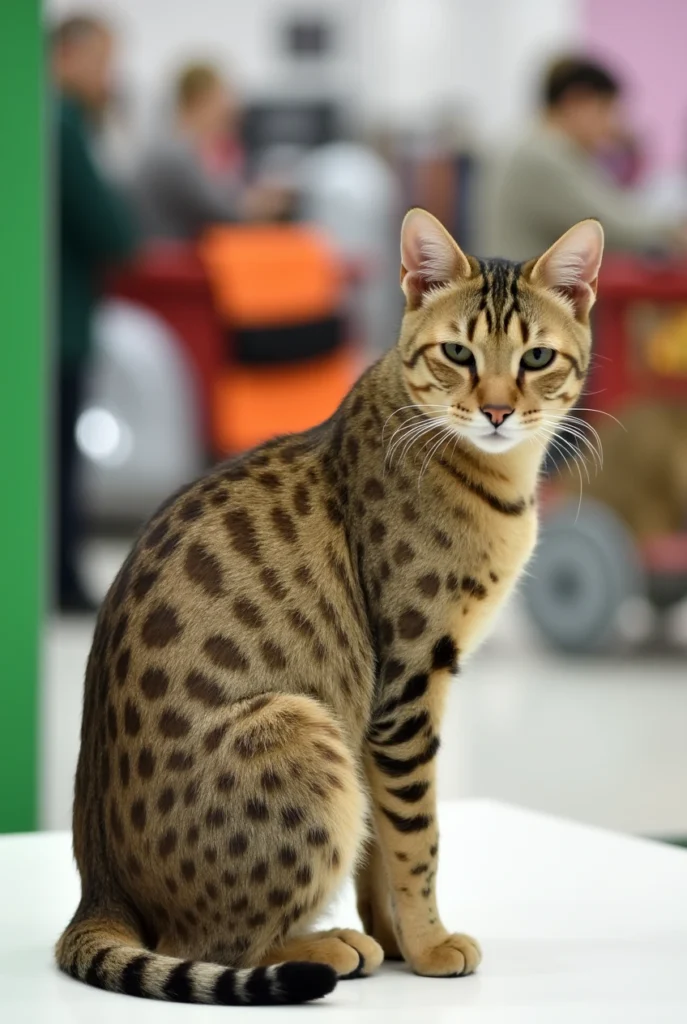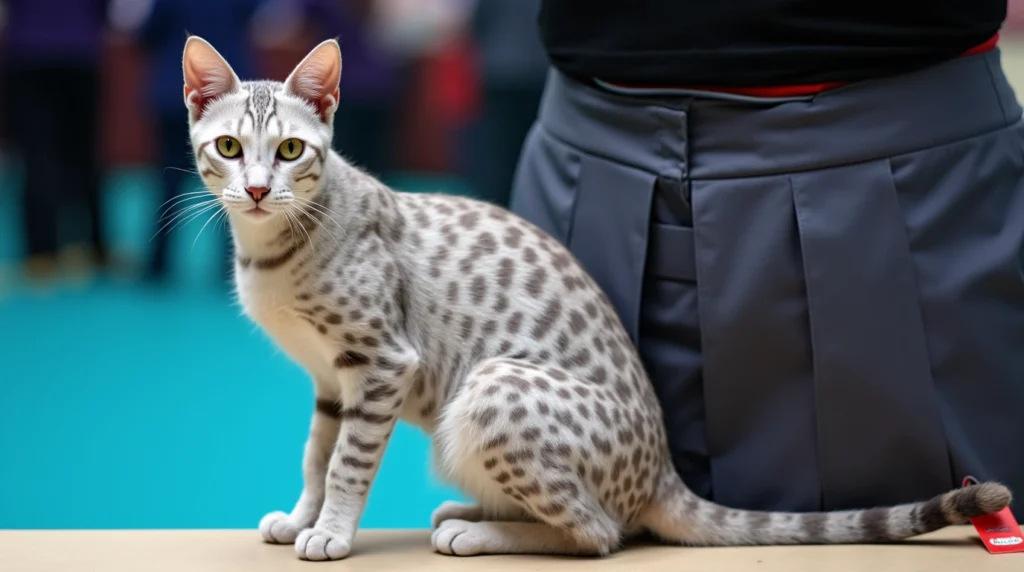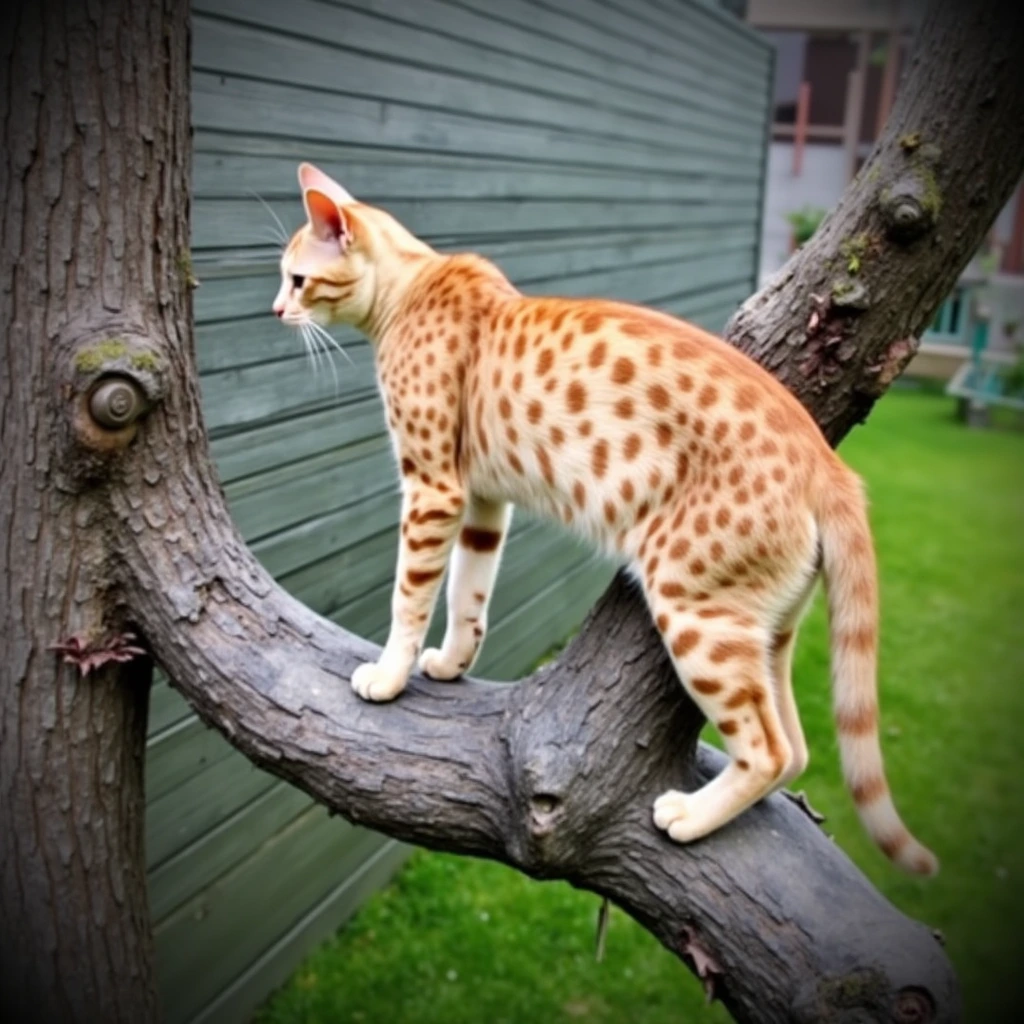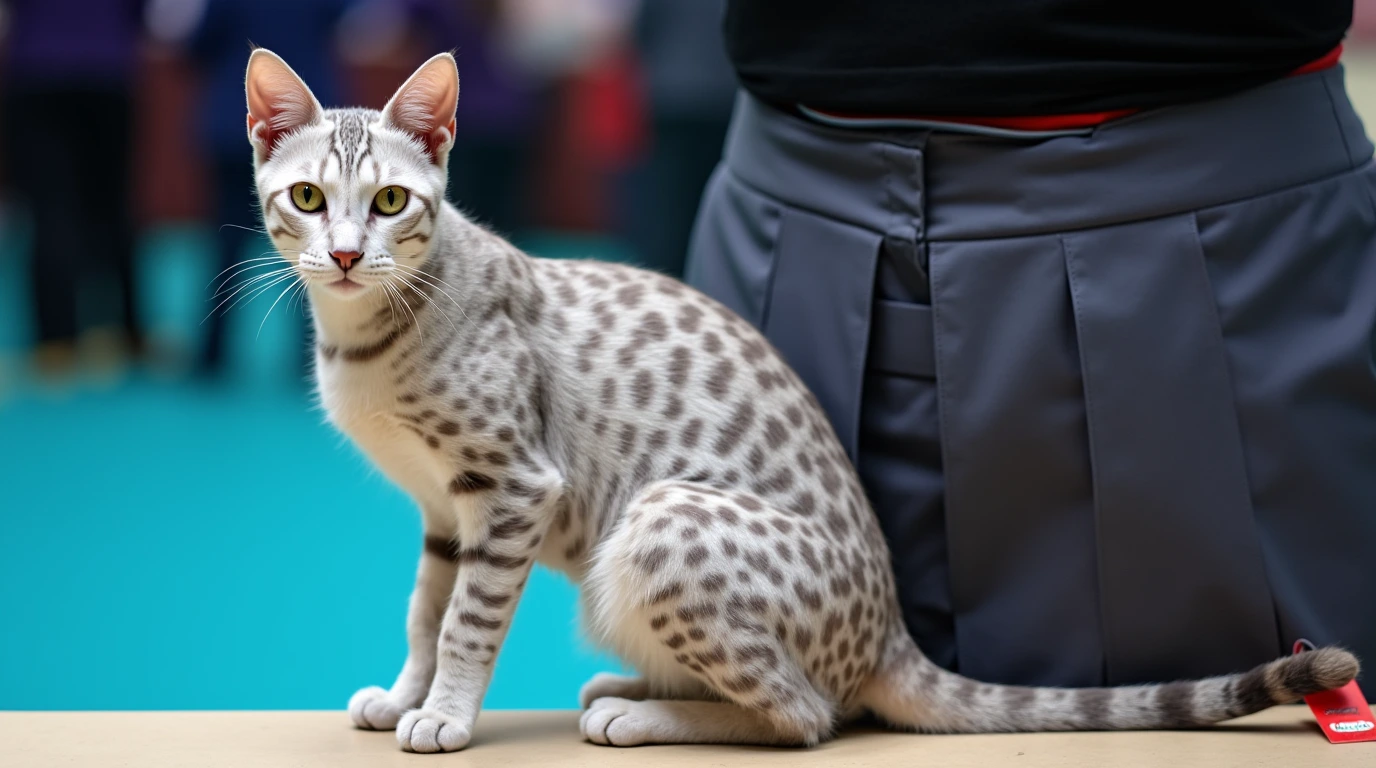There’s something magnetic about a cat that looks like it belongs in the wild — but curls up on your couch like it owns the place. Enter the Ocicat Chatur — a spotted feline with the grace of a jungle predator and the wit of your sharpest friend. If you’ve ever imagined naming a cat “Chatur” (clever, cunning, always one step ahead), this breed wears the title like a second skin.
The Ocicat wasn’t engineered for exotic looks — it was an accident, and a brilliant one at that. A breeder’s unexpected experiment in the U.S. gave rise to this stunning hybrid: the body of a domestic cat, the markings of an ocelot, and a mind that’s practically feline Mensa material. But “Chatur” isn’t just a descriptor here — it’s a personality stamp. These cats open doors (literally), play fetch, and pick favorites in the household like little politicians.
This guide isn’t just about the facts — it’s about whether the Ocicat Chatur is your kind of cat. You’ll get the real story behind its origin, what it’s like to live with one (spoiler: they don’t just follow you — they monitor you), and how to care for a creature this beautiful and brainy.
So if you’re curious about clever cats that act more like witty roommates than aloof loners, stick around. The Ocicat Chatur might just be the feline spirit you’ve been missing.
Table of Contents

Origins and Development of the Ocicat Chatur
The story of the Ocicat Chatur begins, fittingly, with a bit of unexpected genius — much like the cats themselves. In the 1960s, breeder Virginia Daly set out to create an Abyssinian-pointed Siamese. But the feline gods had other plans. When her Siamese-Abyssinian hybrid was crossed again with a Siamese, one kitten in the litter looked… wild. Spotted. Exotic. She named him “Tonga.” And just like that, the Ocicat was born — not from a jungle, but from a living room in Michigan.
At first, Tonga was a one-off. Daly hadn’t planned to continue the line, and Tonga was neutered. But the spotted beauty stirred interest. With encouragement from geneticists and breeders, she began intentionally replicating the look. The recipe? A clever mix of Siamese, Abyssinian, and later American Shorthair to add bone structure and silver coloring. The result? A cat that looked like an ocelot, behaved like a sociable shadow, and could be trained like a dog.
This origin story sets the tone for why the name “Chatur” fits like a paw in a velvet glove. These cats are accidental masterminds — born of crossbreeding curiosity, but sharp and sophisticated in their own right. They weren’t created to look smart; they simply are.
By the late 1980s, major cat associations recognized the Ocicat. But unlike some show breeds that thrive in the limelight but flounder in homes, Ocicats adapt, bond deeply, and bring flair to everyday life. They’re not museum pieces — they’re dynamic members of the household.
Why Their Origin Matters to You
Understanding the Ocicat’s development gives you more than trivia — it shows you’re adopting a breed that wasn’t designed for flash, but ended up dazzling anyway. That says something about their nature: confident, self-possessed, and a little mischievous — just like any true “Chatur.”
FAQ – Did the Ocicat come from wildcats?
No. Despite their ocelot-like appearance, Ocicats have zero wild DNA. They are entirely domestic and were bred through careful crosses of known domestic breeds. So while they look like tiny leopards, they’re every bit as homegrown as your average tabby — just with better style and higher IQ.
Physical Characteristics of the Ocicat Chatur
At first glance, the Ocicat Chatur is a walking contradiction. It looks like it just stepped out of a rainforest documentary — wild, athletic, and untamed — but it’s as domestic as a kitchen sink nap. The first thing you’ll notice? Those striking spots. Symmetrical, thumbprint-shaped, and scattered like a painter’s deliberate splatter, they stretch across a body that’s long, lean, and surprisingly heavy when you pick it up.
Built for both grace and grit, the Ocicat’s muscular frame is reminiscent of its American Shorthair lineage — all power tucked under elegance. The legs are medium-long, and the hindquarters give off a low-slung jungle cat vibe, almost like the feline version of a coiled spring. But don’t be fooled — it’s not just for show. These cats can leap, twist, and pounce with ninja-like control.
The coat? Satin-like, short, and close to the body. Low-maintenance but high-reward. It gleams in the light and comes in a range of colors — tawny, chocolate, cinnamon, blue, lavender, fawn, and silver variations of all the above. Each one tells its own visual story, but all stay true to the breed’s hallmark: those wild, unmistakable spots.
Eyes are almond-shaped and slightly angled, usually gold or green, depending on coat color. The ears tilt forward, often with a hint of lynx tip. Altogether, the Ocicat gives off the kind of regal presence you’d expect from a creature with both ancient instincts and modern charm.
Ocicat Chatur vs. Wild Lookalikes
It’s easy to mistake an Ocicat for something… less domesticated. But unlike actual wild hybrids like Bengals or Savannahs, Ocicats have a gentler expression and lack that exaggerated jaw or glassy stare. They exude a softer intensity — aware, alert, but inviting.
FAQ – Do all Ocicats have spots?
Yes — if it’s a true Ocicat. The breed standard demands well-defined spots across the sides, shoulders, and haunches. Some kittens may be born with faint markings, but mature Ocicats always display a full spotted pattern if they meet the breed’s criteria.

Personality and Temperament of the Ocicat Chatur
Let’s be blunt — if you’re after a quiet lap cat that snoozes through life, the Ocicat Chatur is not your match. But if you want a feline with charisma, intelligence, and just the right amount of attitude, this cat might as well come with a resume. “Chatur,” after all, means clever — and this breed lives up to it in every sense.
Ocicats are social strategists. They read the room better than some people. Not only will they remember where you keep the treats — they’ll figure out how to open the cabinet. They thrive on interaction and don’t just tolerate humans, they recruit them. Many owners report their Ocicat acting more like a dog: fetching toys, greeting guests, even walking on a leash if trained early. But don’t mistake obedience for subservience — Ocicats play the game because they want to, not because they have to.
They’re also deeply emotional. Leave them alone too long, and they’ll show their disappointment — sometimes by rearranging your bookshelves (read: knocking everything off them). They bond tightly with families and typically pick a favorite person. They’re excellent with kids, gentle with elderly companions, and surprisingly chill with other pets, even dogs, as long as introductions are respectful.
And oh yes — they talk. Not in the loud, demanding tone of a Siamese, but with a conversational chirp and curious trill that makes you feel like you’re genuinely being spoken to. Ocicats want to be involved in everything: cooking, laundry, typing… you name it, they’ll supervise.
The Clever Side of “Chatur”
- Opens doors and drawers (child locks may be required)
- Learns routines fast — even manipulates them
- Can be taught tricks, names of toys, even commands
- Problem-solves boredom: not always to your benefit
FAQ – Are Ocicats good for first-time cat owners?
Yes, if you’re ready for a cat that acts like a curious toddler. They’re affectionate, adaptable, and easy to train, but they do need attention, stimulation, and space to explore. If you’re gone most of the day, consider a second pet for company — or prepare for some creative destruction.
Care Requirements for the Ocicat Chatur
Living with an Ocicat Chatur isn’t about maintenance — it’s about engagement. These cats are low-effort on the grooming front, but high-demand when it comes to mental and emotional interaction. If you’ve ever tried to entertain a brilliant, hyper-curious child who gets bored with toys in five minutes… you’re halfway to understanding what care for this cat looks like.
Let’s start with the easy part: grooming. The Ocicat’s short, tight coat practically takes care of itself. A weekly brush with a rubber glove or fine-toothed comb keeps their fur glossy and your furniture less fuzzy. They’re not prone to matting, and they don’t shed as heavily as fluffier breeds — making them surprisingly manageable for allergy-sensitive homes (though not hypoallergenic).
Now onto the part most owners underestimate: mental stimulation. These cats need more than feather toys. They crave puzzles, hide-and-seek games, food mazes, interactive play, and above all — your presence. Leave an Ocicat alone with nothing to do, and they’ll invent entertainment… sometimes using your belongings.
Physical activity is just as crucial. Ocicats are lean because they move — and they expect you to be their gym buddy. Set up vertical climbing spaces, cat trees, window hammocks, or even try clicker training. (Yes, they’ll sit, high-five, and spin — for a snack.)
Diet-wise, they do best on a high-protein, grain-conscious diet — think quality wet food supplemented with high-meat dry kibble, depending on your vet’s guidance. Like most intelligent breeds, Ocicats benefit from scheduled meals rather than free-feeding. They learn food routines fast… and exploit them faster.
What Your Ocicat Chatur Needs Daily
- At least 20–30 minutes of interactive play
- Access to windows or climbing spaces
- Puzzle feeders or rotating toys
- Consistent feeding and sleep routines
- Your attention — seriously, they notice when you’re distracted
FAQ – Do Ocicats get bored easily?
Absolutely — and they’ll show it. An under-stimulated Ocicat may become vocal, mischievous, or destructive. These cats are happiest in homes where their brains are exercised as much as their bodies. If you work long hours, plan for enriching solo activities or a second pet for company.

Health Considerations of the Ocicat Chatur
For a breed that looks wild, the Ocicat Chatur is surprisingly hardy. Thanks to its diverse gene pool — rooted in Siamese, Abyssinian, and American Shorthair lines — this breed generally enjoys good health. But even the cleverest cats aren’t immune to a few biological hiccups.
Let’s be real: no cat breed is completely without risk. Ocicats can be prone to a few hereditary conditions, mostly inherited from their Siamese or Abyssinian ancestors. Chief among them is hypertrophic cardiomyopathy (HCM), a common feline heart condition. It can be asymptomatic for a long time, which is why annual veterinary checkups (with occasional echocardiograms) are a smart investment.
Another one to watch: renal or liver issues. While not as widespread in Ocicats as in purebred Siamese, kidney health is worth tracking — especially as your cat reaches middle age. Regular blood panels can catch early signs before they become problems.
Also worth noting — dental disease. Ocicats, like many cats with Siamese roots, may experience gum sensitivity or tartar buildup. Weekly brushing (yes, it’s possible) and routine vet cleanings help extend their oral health and overall longevity.
Vaccinations, parasite control, and neutering/spaying fall under the standard health checklist — but Ocicats tend to recover well from routine procedures, and most owners report them bouncing back faster than expected. Possibly because they’re too curious to rest.
Longevity and Preventive Care
With good care, Ocicat Chaturs typically live between 12–18 years. Some push 20. The keys? Clean diet, active lifestyle, and proactive health monitoring.
- Schedule wellness exams once a year (twice for seniors)
- Brush their teeth weekly if possible
- Monitor for early signs of lethargy or rapid weight changes
- Provide clean, filtered water (kidney support 101)
FAQ – Is pet insurance worth it for an Ocicat?
Yes — if you plan to cover any surprises. Ocicats are generally healthy, but their curious nature can lead to unexpected accidents (like swallowing string, or leaping into something breakable). Insurance helps cover the “just in case” vet bills you’ll wish you had help with when they happen.
Living with an Ocicat Chatur
Living with an Ocicat Chatur is like sharing space with a whip-smart, emotionally invested, highly mobile housemate — who doesn’t pay rent but insists on co-managing your life. This cat doesn’t “live” in your home; it participates in it. Fully. Intentionally. And often, hilariously.
Adaptability is one of the breed’s strongest traits. Whether you’re in a spacious house or a cozy apartment, as long as there’s vertical space, stimulation, and interaction, the Ocicat will thrive. They don’t hide under beds or vanish for hours like some introverted breeds. They want to be where you are — and they’ll follow you from room to room like a shadow with spots.
Got kids? They’re a win. Ocicats are tolerant, gentle, and playful, making them an ideal match for families with children. They seem to intuitively understand how to dial their energy up or down depending on their human playmate. Elderly owners often describe them as “conversational companions” — responsive, attentive, and tuned into mood shifts.
And what about other pets? Surprisingly smooth. Many Ocicats live peacefully with dogs, rabbits, and even birds (with boundaries). The key is structured introductions and early exposure. Once acclimated, they often form bonds with other animals — or at the very least, a sort of amused tolerance.
Noise, new people, and travel? Ocicats handle it all better than most cats. They’re not skittish or easily startled. In fact, some owners report that their Ocicat insists on being part of travel plans. Harness-train them early, and they’ll ride in a car like a pro.
Tips for a Happy Coexistence
- Rotate toys to keep things fresh
- Use feeding puzzles or hide treats around the home
- Set up vertical exploration areas (cat shelves, towers)
- Make space for cuddles — they’ll demand them
FAQ – Can Ocicats be left alone during the day?
Yes, but with caution. They can handle solo time if properly enriched — puzzle feeders, window views, interactive toys. But if you’re consistently gone for long stretches, consider a second pet or a midday play visit. Loneliness breeds mischief in a cat this smart.
Frequently Asked Questions about the Ocicat Chatur
Even with all the details, there’s always that one burning question that nags you at 11 p.m. when you’re deep in a cat-browsing rabbit hole. So, here are some of the most common questions people ask before inviting an Ocicat Chatur into their lives — answered plainly and with a touch of honesty.
Is the Ocicat really that smart?
Yes — and sometimes too smart for your convenience. Ocicats pick up routines fast, can learn tricks, and have been known to open doors, drawers, and even unlock puzzle feeders meant for dogs. They don’t just remember things; they apply them creatively. Think of them as little feline tacticians.
Are Ocicats hypoallergenic?
No, but they’re better than most. Their short, close-lying coat sheds less dander than long-haired breeds, and many allergy-sensitive owners report fewer symptoms. Still, every person reacts differently — so always spend time with one first if you’re unsure.
Can I train an Ocicat like a dog?
Surprisingly, yes. They respond well to clicker training, positive reinforcement, and even basic commands like “sit,” “come,” and “high five.” Just keep sessions short and fun — Ocicats don’t do boring.
Do they need a companion?
Not always, but they do need companionship. If you’re home often and engaged, one Ocicat might be plenty. But if you’re gone all day, they’ll thrive with a second cat, a cat-friendly dog, or a regular play schedule.
How much do Ocicat Chaturs cost?
Prices vary depending on lineage, breeder reputation, and region, but expect a range between $800–$2,500 for a kitten from a reputable breeder. Pet-quality kittens tend to be on the lower end; show-quality or rare colorations cost more. Adoption is possible but rare — Ocicats aren’t common in shelters.
Is the Ocicat Chatur Right for You?
So here we are — you’ve met the wild-looking, house-loving, brainy feline that is the Ocicat Chatur. It’s not just a cat. It’s a statement. A personality. A presence that doesn’t fade into the furniture but actively rearranges your daily rhythm (and sometimes your actual furniture).
If you’re someone who wants a companion, not a decoration… a conversational partner, not a passive pet… and you’re okay with a little clever chaos now and then — this might be your cat. The Ocicat brings beauty, brains, and a surprising depth of emotional awareness to your home. It watches, responds, adapts — and yes, even plots a little. But always in good fun.
It’s not a breed for everyone. If you’re often away, crave quiet, or prefer low-maintenance pets, the Ocicat might overwhelm you. But if you’re ready for engagement, connection, and a daily reminder that animals can be shockingly tuned in — then you may have just met your match.
And if you name yours “Chatur”? Well, don’t be surprised when it lives up to the name — and then some.

